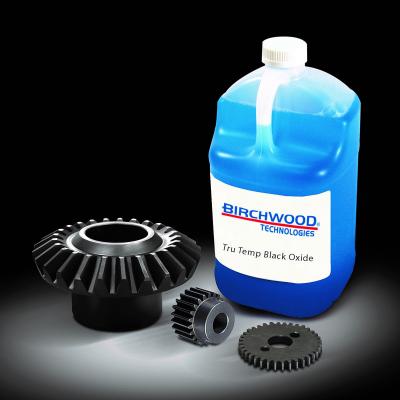
Gear component manufacturers can easily achieve break-in lubricity, robust corrosion protection and galling resistance on critical components. Birchwood Technologies’ TRU TEMP low-temperature, black-oxide process meets demanding finishing requirements while creating a non-dimensional finish, maintaining the same material hardness and load-bearing properties.
The TRU TEMP blackening line operates at 200 degrees and forms a satin black magnetite finish that protects critical surfaces in storage, shipment and startup, resists galling and aids in break-in. The process takes just 30 minutes.
The TRU TEMP finish is Mil Spec and RoHS compliant, and withstands up to 120 hours of neutral salt spray or several hundred hours of humidity, verified by independent testing. The finish is 0.5 microns thick (20 millionths) crystalline structure that allows it to effectively hold a rust inhibitor and serves as a sacrificial barrier to provide break-in lubricity and galling resistance. Critical parts are protected for storage or overseas shipment.
Gear component manufacturers who have already installed a TRU TEMP low-temperature, black-oxide system are amazed at the many benefits they have achieved. The process can be installed in any plant setting, without endangering personnel or surrounding equipment. The operating solutions contain no EPA regulated chemicals; process rinse waters are normally sent to the sewer as non-hazardous discharge. Most process lines do not require waste treatment equipment.
TRU TEMP process lines are available in any size to fit part size and production volume.
Contact Details
Related Glossary Terms
- galling
galling
Condition whereby excessive friction between high spots results in localized welding with subsequent spalling and further roughening of the rubbing surface(s) of one or both of two mating parts.
- hardness
hardness
Hardness is a measure of the resistance of a material to surface indentation or abrasion. There is no absolute scale for hardness. In order to express hardness quantitatively, each type of test has its own scale, which defines hardness. Indentation hardness obtained through static methods is measured by Brinell, Rockwell, Vickers and Knoop tests. Hardness without indentation is measured by a dynamic method, known as the Scleroscope test.
- lubricity
lubricity
Measure of the relative efficiency with which a cutting fluid or lubricant reduces friction between surfaces.
